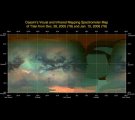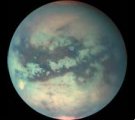Titan Flyby - January 2006
14 January 2006
Only 21 days after T9, Cassini returns to Titan for its eleventh targeted encounter: T10. The closest approach to Titan occurs on Sunday, 15 January, at 11:41 UT at an altitude of 2043 km above the surface and at a speed of 5.8 kilometres per second. The latitude at closest approach is 0°(equator) and the encounter occurs on orbit number 20.This encounter is set up with two manoeuvres: an apoapsis manoeuvre scheduled for 2 January 2006, and an approach manoeuvre, scheduled for 12 January. However, the apoapsis manoeuvre is so small that it has been cancelled. This inbound encounter occurs about 2 days prior to Saturn closest approach.
Science Activities
- Imaging Science Subsystem (ISS)
Perform two mosaics near Xanadu and the dark region, including the Huygens landing site. The closer mosaic will have pixel scales of ~600-350 m. - Composite Infrared Spectrometer (CIRS)
Observing Titan's limb at +55° latitude. This is expected to be near the transition to a possible winter polar vortex region over the north pole, where strong zonal winds in the stratosphere inhibit mixing of air with lower latitudes. CIRS will also perform hemispheric temperature mapping in the stratosphere. - Ultraviolet Imaging Spectrograph (UVIS)
Will perform a global spectral map to study aerosol scattering and hydrocarbon absorption and distribution. This will also be UVIS' first solar occultation. With the solar occultation UVIS can observe the extreme ultraviolet (EUV) spectrum below 110 nm and can sample opacity from nitrogen and methane and possibly some other hydrocarbons. - Visual and Infrared Mapping Spectrometer (VIMS)
Obtain new high resolution images that will help understand Titan's geology and the fate of CH4. - Dual Technique Magnetometer (MAG)
MAG will take advantage of this encounter being upstream of the Titan/magnetospheric interaction. The spacecraft will fly through Titan's middle ionosphere. Together with the T8 and T6 flybys, T10 will allow MAG to reconstruct the upstream equatorial ionospheric pile-up region. - Magnetospheric Imaging Instrument (MIMI)
Observe details of the Titan/magnetospheric interaction by observing within a one-hour period of closest approach. MIMI will also observe Titan's exosphere/magnetospheric interaction by imaging energetic neutral atoms (ENA) with the Ion and Neutral Camera (INCA). - Ion and Neutral Mass Spectrometer (INMS)
Obtain data regarding Titan's atmospheric and ionospheric composition and thermal structure. INMS will also observe the magnetospheric/ionospheric interaction. - Radio and Plasma Wave Science (RPWS)
Study the interaction of the magnetosphere with Titan at intermediate distances for evidence of ion pickup, radio emissions, density profiles, and the general wave environment.
Table of Events
17 December 2005
| Time UTC | Time wrt Titan-10 |
Event |
| 14:21:00 | - 28d 21h | Start of sequence S17 which contains T10 |
12 January 2006
| Time UTC | Time wrt Titan-10 |
Event |
| 03:23:00 | - 03d 08h | OTM #49 Prime; T10 minus 3 day targeting manoeuvre |
13 January 2006
| Time UTC | Time wrt Titan-10 |
Event |
| 03:23:00 | - 02d 08h | OTM #49 Backup |
14 January 2006
| Time UTC | Time wrt Titan-10 |
Event |
| 13:38:00 | - 22h 03m | Start of the TOST segment |
| 13:38:00 | - 22h 03m | Turn cameras to Titan |
| 14:08:00 | - 21h 33m | Deadtime, used to accommodate changes in flyby time |
| 14:23:00 | - 21h 18m | Infrared observations; temperature mapping and composition determination |
15 January 2006
| Time UTC | Time wrt Titan-10 |
Event |
| 01:41:00 | - 10h 00m | NAC observations; monitor for surface and atmospheric changes |
| 02:41:00 | - 09h 00m | Infrared limb observations; obtain information on trace constituents in stratosphere |
| 06:41:00 | - 05h 00m | NAC observations; low-phase angle global map |
| 11:01:00 | - 00h 40m | UVIS solar occultation observation; target the Sun as it passes down through Titan's atmosphere and then back out again |
| 11:41:27 | + 00h 00m | Closest approach; altitude=2043 km, speed=6 kms-1, 120° phase at closest approach |
| 12:41:00 | + 01h 00m | Far infrared limb observations; vertical sounding of stratospheric compounds in the stratosphere (including H2O) |
| 13:41:00 | + 02h 00m | VIMS search for lightning |
| 14:41:00 | + 03h 00m | Ultraviolet imaging; slow scan to form spectral images |
| 19:41:00 | + 08h 00m | NAC nightside imaging; search for and monitor lightning/aurora |
16 January 2006
| Time UTC | Time wrt Titan-10 |
Event |
| 02:24:00 | + 14h 43m | Deadtime, used to accommodate changes in flyby time |
| 02:35:00 | + 14h 45m | Turn to Earth-line |
| 03:05:00 | + 15h 24m | Begin playback of T10 data; Goldstone 70m |
| 12:05:00 | + 01d 00h | End playback of T10 data |
17 January 2006
| Time UTC | Time wrt Titan-10 |
Event |
| 06:58:00 | + 01d 19h | Saturn periapsis |
Observation Results
Cassini Instrument: Visual and Infrared Mapping Spectrometer (VIMS)
Last Update: 1 September 2019



